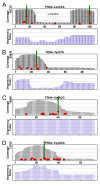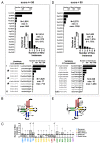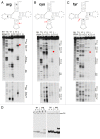Diversity of human tRNA genes from the 1000-genomes project
- PMID: 24448271
- PMCID: PMC3917988
- DOI: 10.4161/rna.27361
Diversity of human tRNA genes from the 1000-genomes project
Abstract
The sequence diversity of individual human genomes has been extensively analyzed for variations and phenotypic implications for mRNA, miRNA, and long non-coding RNA genes. TRNA (tRNA) also exhibits large sequence diversity in the human genome, but tRNA gene sequence variation and potential functional implications in individual human genomes have not been investigated. Here we capitalize on the sequencing data from the 1000-genomes project to examine the diversity of tRNA genes in the human population. Previous analysis of the reference human genome indicated an unexpected large number of diverse tRNA genes beyond the necessity of translation, suggesting that some tRNA transcripts may perform non-canonical functions. We found 24 new tRNA sequences in>1% and 76 new tRNA sequences in>0.2% of all individuals, indicating that tRNA genes are also subject to evolutionary changes in the human population. Unexpectedly, two abundant new tRNA genes contain base-pair mismatches in the anticodon stem. We experimentally determined that these two new tRNAs have altered structures in vitro; however, one new tRNA is not aminoacylated but extremely stable in HeLa cells, suggesting that this new tRNA can be used for non-canonical function. Our results show that at the scale of human population, tRNA genes are more diverse than conventionally understood, and some new tRNAs may perform non-canonical, extra-translational functions that may be linked to human health and disease.
Keywords: 1000 genomes project; SNP; isodecoder; tRNA.
Figures





References
-
- Manning AK, Hivert MF, Scott RA, Grimsby JL, Bouatia-Naji N, Chen H, Rybin D, Liu CT, Bielak LF, Prokopenko I, et al. DIAbetes Genetics Replication And Meta-analysis (DIAGRAM) Consortium. Multiple Tissue Human Expression Resource (MUTHER) Consortium A genome-wide approach accounting for body mass index identifies genetic variants influencing fasting glycemic traits and insulin resistance. Nat Genet. 2012;44:659–69. doi: 10.1038/ng.2274. - DOI - PMC - PubMed
Publication types
MeSH terms
Substances
Grants and funding
LinkOut - more resources
Full Text Sources
Other Literature Sources
